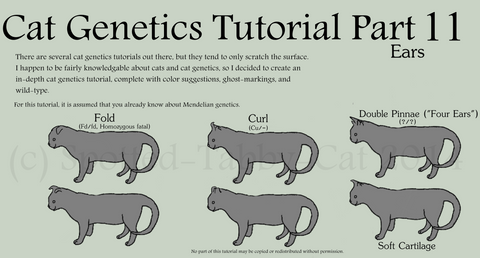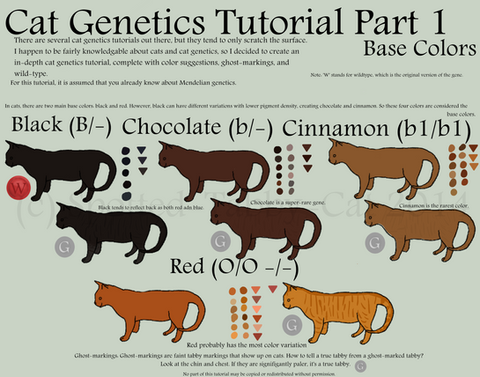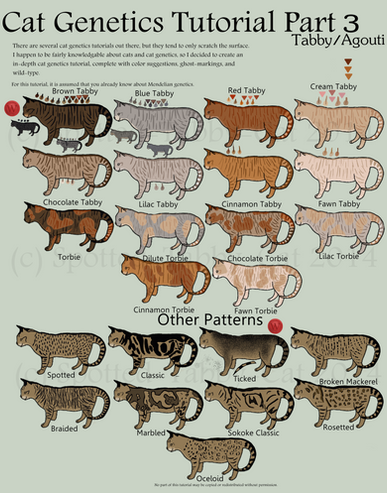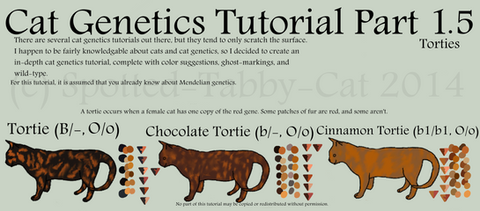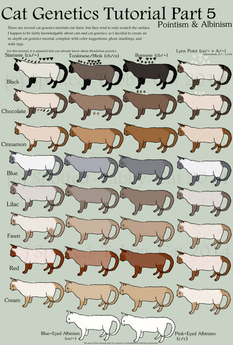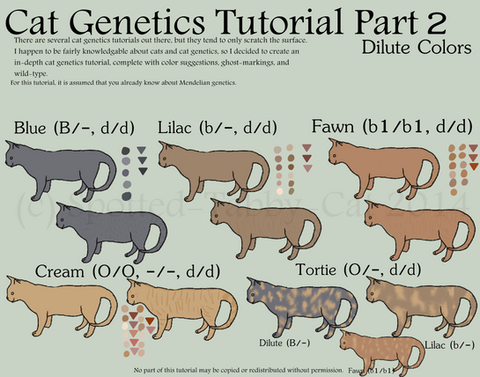HOME | DD
 Spotted-Tabby-Cat — Cat Genetics Tutorial Part 12 (Other)
Spotted-Tabby-Cat — Cat Genetics Tutorial Part 12 (Other)

Published: 2016-12-22 02:46:32 +0000 UTC; Views: 11797; Favourites: 107; Downloads: 92
Redirect to original
Description
This tutorial is out of date. Please see more information here .
There are multiple cat genetics tutorials about, but they tend to only cover the basics (base colors, dilutions, tabby, white-spotting, pointism, & tortie/orange). In-depth cat genetics tutorials tend to be lacking. So thus, this. I have no idea how long this will take to be completed. Hopefully before 2016 2017.
I've already covered most things in cat genetics, but here are a few more. The mica effect causes the tips of a cat's hair to look shiny and with a silvery tinge. Russian Blues, such as this one , tend to have this. The actual effect is caused by the tip of the hair being too thin for pigment granules to reach, creating the effect. It also tends to accumulate around the muzzle and paws, making those seem lighter in color. Satin is similar, although it only changes the hair to make it shinier, causing shiny cats. Birman gloving is a theoretical gene that would cause white markings on the paws of cats, specifically the Birman breed which is well known for it. All three of the previous genes are assumed to be recessive. Polydactylism is a condition in where a cat has extra toes, from one or two to essentially another foot growing out of that leg. Generally, polydactyl cats are fine and live normal cat lives. A dominant gene (Pd/pd) causes most polydactylism (though of course random mutation can affect limb development in some cats).
Like any other animal, cats have mutations and new genes can crop up and change a cat's appearance. Messybeast is a great place to keep up with new mutations, and if anything throughout this tutorial is unclear, feel free to ask me any questions.
Part 1 (Base Colors):
Cat Genetics Tutorial Part 1 (Base Colors)
Part 1.5 (Torties):
Cat Genetics Tutorial Part 1.5 (Torties)
Part 2 (Dilutions):
Cat Genetics Tutorial Part 2 (Dilutions)
Part 3 (Tabby):
Cat Genetics Tutorial Part 3 (Tabby/Agouti)
Part 4 (White-Spotting):
Cat Genetics Tutorial Part 4 (White)
Part 5 (Pointism & Albinism):
Cat Genetics Tutorial Part 5 (Pointism & Albinism)
Part 6 (Silver & Gold Series):
Cat Genetics Tutorial Part 6 (Silver & Gold Series)
Part 7 (Color Changes):
Cat Genetics Tutorial Part 7 (Color Changes)
Part 8 (Weirdos):
Cat Genetics Tutorial Part 8 (Weirdos)
Part 9 (Hair):
Cat Genetics Tutorial Part 9 (Hair)
Part 10 (Tail):
Cat Genetics Tutorial Part 10 (Tail)
Part 11 (Ears):
Cat Genetics Tutorial Part 11 (Ears)
Part 12 (Other):
Cat Genetics Tutorial Part 12 (Other)
Related content
Comments: 10

👍: 0 ⏩: 0

👍: 0 ⏩: 0

This orange tabby cat appears to have a white or whited underside, feet, and mostly white tail. Most tabbies don't have undersides or feet that whited or white nor do they have mostly white tails.
This cat appears to have a pattern resembling the horse pattern known as pangaré or mealy instead of the white spotting pattern.
Pangaré or mealy gives a horse a uniformly symmetrical gradated lighter, whited, or white belly or undersides, muzzle, and feet.
Reasons that rule out the white spotting pattern
1) This cat has a mostly white tail. Any white-spotted cat with less than Grade 9 white spotting has a completely colored tail outside of the optional white tail tip.
2) The delineations between the white or whited areas and the colored areas on this cat appear smooth and gradated. The delineations between the white areas and the colored areas on a white spotted cat appear sharp.
3) The tabby stripes cut through the white or whited areas on this cat. Tabby stripes don't cut through the white areas on white spotted cats.
4) The whited or white area on this cat appears uniformly symmetrical. White spotted patterns can be asymmetrical, especially in high grade forms like harlequin.
it may be easier to achieve a pangaré or mealy appearance in a tabby than in a solid colored cat because tabbies often have lighter undersides whereas solid colored cats don't. The closest to mealy that solid colored cats get to a mealy appearance is with the muzzle and toes of solid grey cats.
This cat also appears to have a medium-haired feathered tail and appear otherwise shorthaired.
Orange Tabby Cat with Pangaré-like pattern:
1.bp.blogspot.com/-rUO7qrqCGTw…
👍: 0 ⏩: 1

looks like hes a red mackerel tabby with the silver mutation to me
👍: 0 ⏩: 0

Is the Glitter/Mica effect seen in Russian Blues the same as the glitter seen in the Bengal breed?
👍: 0 ⏩: 1

There isn't a lot of information available on the genetics, but from what I could find, the Bengal glitter seems to be a combination of mica and satin effects, so the answer to your question would be yes and no. Sorry that this reply has taken so long.
👍: 0 ⏩: 1

Thank you! It's fascinating all the different characteristics and colors combine.
👍: 0 ⏩: 1

You're welcome! It is absolutely fascinating!
👍: 0 ⏩: 0


